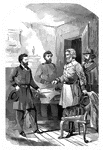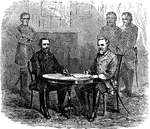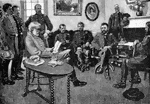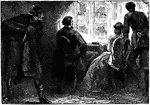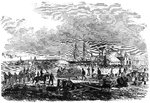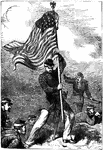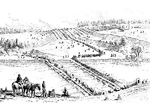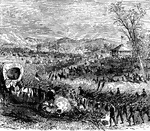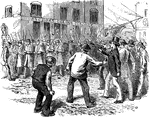The 1861-1865 Civil War Other Events ClipArt gallery includes 137 illustrations of other important events that occurred during the American Civil War.

Lee's Army
"Lee's army crossing the Potomac at Williamsport, in scows guided by wires, after the invasion of Maryland."—…
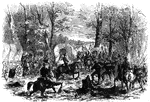
Lick Creek Bottom
"Advance of Federal troops on Corinth- the Carnival of Mud- scene at Lick Creek Bottom, between Pittsburg…
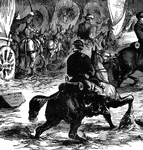
Lick Creek Bottom - Horse and Rider
"Advance of Federal troops on Corinth- the Carnival of Mud- scene at Lick Creek Bottom, between Pittsburg…
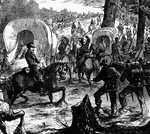
Lick Creek Bottom - In the Mud
"Advance of Federal troops on Corinth- the Carnival of Mud- scene at Lick Creek Bottom, between Pittsburg…
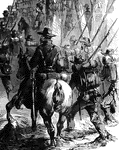
Lick Creek Bottom - Marching through the Mud
"Advance of Federal troops on Corinth- the Carnival of Mud- scene at Lick Creek Bottom, between Pittsburg…
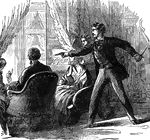
Lincoln Assassination
This illustration shows the assassination of President Lincoln by John Wilkes Booth.

Diagram of Box Occupied by President Lincoln in Theatre
A diagram of the box occupied by President Lincoln in the Ford Theater when he was assassinated.

Macon Railroad
"Sherman's campaign in Georgia- Federal forces at Jonesborough destroying the Macon Railraod."— Frank…
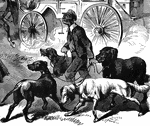
Man Walking Dogs
"Man walking dogs in the 'Grand Skedaddle' of the inhabitants from Charleston, S. C., when threatened…

Manassas
"The war in Virginia--General Hooker's army marching past Manassas, Va., June, 1863."— Frank Leslie,…
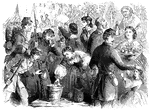
Daughters of Maryland
"How the Daughters of Maryland received the Sons of the North as they marched against the Confederate…
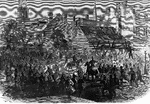
Invasion of Maryland
"The invasion of Maryland- citizens of Baltimore barricading the streets, Monday evening, June 29th,…

Arrival of General McClellan
April 5, 1862. The General is arriving to take personal command of the Federal Army in its advance on…

General McGowen
"General McGowen addressing the Thirty-Fifth Abbeville (S. C.) Volunteers, in front of the Charleston…

Thomas Francis Meagher
Thomas Francis Meagher (August 3, 1823 – July 1, 1867) was an Irish nationalist, a Union Army…

Discovery of a Confederate Battery at Messech's Point
The activity of the Confederates on the Potomac and the confluent rivers was almost incredible. In one…

New Fernandina
"Federal troops marching through Second Street, New Fernandina, Fla. Our sketch of New Fernandina in…
Occupation of Norfolk
"Occupation of Norfolk, VA., by the Federal troops- view of the city- Federal vessels at anchor." —Leslie,…

Northern Armies
"The enthusiasm of the Northern armies- re-enlistment of the Seventeenth Army Corps. Financial tests…

Landing at Parkersburg
"Landing of Federal troops at Parkersburg, Western Virginia. Parkersburg, Va., in 1861 was a thriving…

Invasion of Pennsylvania
"The invasion of Pennsylvania- working on the fortifications near Harrisburg, Pa., June 16th, 1863.…

Pontoon bridge
"General Fremont's Division crossing the Pontoon Bridge over the Shenandoah River in pursuit of the…
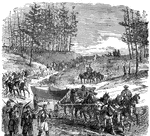
Pontoon Bridge
"The Pontoon bridge 'On The March'- the pontoon wagons on their way from Aquia Creek to the Rappahannock.…

Army of the Potomac
"Army of the Potomac recrossing the Rappahannock from Fredericksburg to Falmouth, on the night of Monday,…

Army of the Potomac
"Advance of the Army of the Potomac. Occupation of Winchester, VA., and the abandoned Confederate Fortifications,…
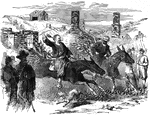
Passage of the Potomac
"A street in Harper's Ferry, VA., during the passage of the Potomac by the Federal troops from Maryland,…

Recrossing the Potomac
"General Banks's Division recrossing the Potomac from Williamsport, Md., to attack the Confederate army…
!["Presentation of colors to the Twentieth United States [African American] Infantry, Colonel Bartram, at the Union League Clubhouse, New York, March 5th, 1864. The Twentieth Regiment, United States [African American] Troops, left Riker's Island at nine o'clock on the 5th of March, 1864, on board the steamer <em>John Romer</em>, and were conveyed to the foot of Twenty-first Street, East River, New York, where they were disembarked and formed in regimental line, and marched to Union Square, arriving in front of the Union League Clubhouse at one o'clock. A vast crowd of citizens, of every shade of color and every phase of social and political life, filled the square and streets, and every door, window, veranda, tree and housetop that commanded a view of the scene was peopled with spectators. Over the entrance of the clubhouse was a large platform, ornamented with flags and filled with ladies. In the street was another platform, tastefully decorated and occupied by prominent citizens. From the stand the colors were presented by President King of Columbia College, who addressed them with warmth and eloquence. After the presentation ceremony was over the men stacked arms and partook of a collation provided for them."— Frank Leslie, 1896](https://etc.usf.edu/clipart/11700/11749/presentcolor_11749_mth.gif)
Presentation of Colors
"Presentation of colors to the Twentieth United States [African American] Infantry, Colonel Bartram,…
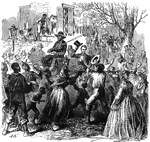
President Lincoln
"President Lincoln riding through Richmond, Va., April 4th, 1865, and the enthusiastic cheers of the…
Prison Reception
"Reception of Confederate prisoners at the Federal prison, Elmira, N. Y. The prison at Elmira, N. Y.,…

Re-enforcements
"Re-enforcements for Grant's army leaving Memphis, Tenn. Our sketch shows the Alice Dean, a…

Reconnoissance
"Reconnoissance by Colonel Max Weber's Turner rifles in the vicinity of Newmarket Bridge, on the road…

Red River
"The war on the Red River. Admiral Porter's fleet passing through Colonel Bailey's Dam, above Alexandria,…

Lincoln Review
In 1863, president Lincoln reviewed some sixty thousand troops in the small town of Falmouth VA. Although…
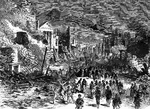
Richmond
"The Federal army entering Richmond, Va., April 3rd, 1865- reception of the troops in Main Street."—…

General Rosecrans
"General Rosecrans, commanding the Department of Western Virginia, surrounded by his staff, at their…

Roswell's Ferry
"The war in Georgia- the Sixteenth Army Corps fording the Chattahoochee at Roswell's Ferry, July 10th,…
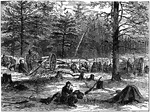
Scene of Sedgwick's Death
John Sedgwick (September 13, 1813 – May 9, 1864) was a teacher, a career military officer, and…
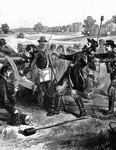
Death of Sedgwick
"Death of General Sedgwick at Spottsylvania, May 9, 1864."—E. Benjamin Andrews 1895

Seventeenth Corps
"Sherman's Seventeenth Corps crossing the south Edisto River, S. C., on Pontoons, at Bennaker's Bridge,…

Crossing of Shenandoah River
"Colonel Pilson's Battery shelling the rear guard of the Confederate General Jackson's Army, at the…
Sheridan's Campaign
"Sheridan's campaign in the Shenandoah Valley- the Federal forces falling back through Charlestown,…
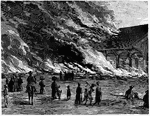
Sherman's Troops Burning a Railroad Station
William Tecumseh Sherman served as a General in the Union Army during the American Civil War. Here his…

Sixteenth Regiment
"The Sixteenth Regiment, Ohio Volunteers, under Colonel Irwine, crossing the tray run viaduct, near…
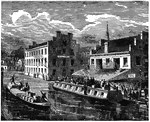
Governor Smith Leaving Richmond
Governor Smith leaving Richmond during the American Civil War campaign against Richmond.
